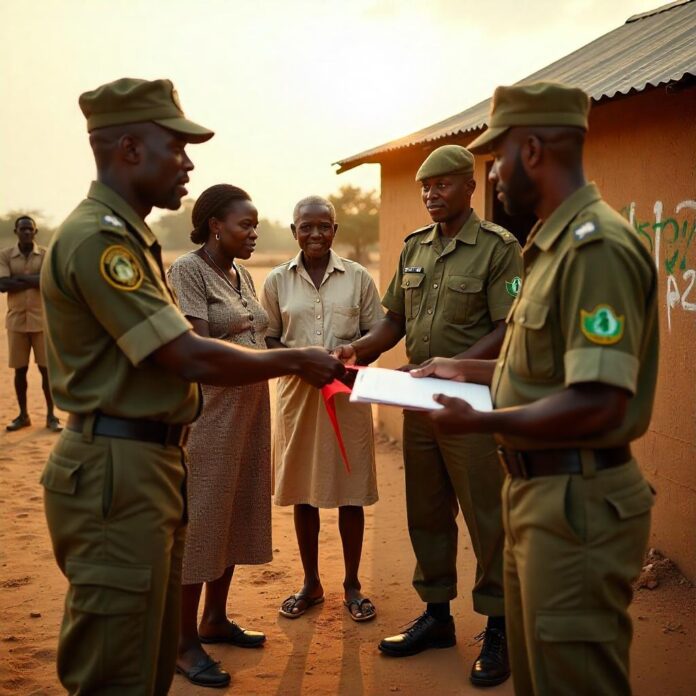The Ceremonial Handshake
As Kaduna’s streets echo with military parades and ribbon-cutting ceremonies, Nigeria marks the 162nd anniversary of its Army with a potent contradiction: gleaming new clinics and schools unveiled while voices in Borno’s displacement camps whisper about temporary solutions. This year’s Nigerian Army Day Celebration pivots on the theme “Developing the Soldier First Concept: Imperative for Nigerian Army’s Transformation Drive”. Yet beneath the fanfare, a critical question simmers: Are these civil projects genuine bridges to civilians, or theatrical distractions from deep-seated distrust?
Roots of the Rift – NADCEL’s Historical Tightrope Walk
The Birth of a Balancing Act
NADCEL isn’t just a birthday party. Born in 1978, it solemnly commemorates two pivotal moments: the Army’s 1863 founding as the “Glover Hausas” and the 1967 first shot of the Civil War at Garkem, Cross River State. This duality mirrors today’s tension – an institution celebrating national protection while wrestling with internal conflict legacies.
From Battlefields to Heartbeats
The Army’s outreach tradition runs deeper than critics acknowledge. During 1960s Congo peacekeeping missions, Nigerian troops shielded civilians amid chaos. Decades later during flood disasters in Maiduguri, soldiers evacuated families despite operational strains. The Army has also undertaken nationwide road and clinic constructions under Civil-Military Cooperation programs. Yet 2025’s aggressive outreach push isn’t accidental. With ongoing operations against Boko Haram, Northwest bandits, and oil bunkering, the Army faces a perception crisis: Protectors or occupiers? Today’s medical camps and school renovations aim to counter this militarization narrative.
The 2025 Gambit – Welfare Warriors or PR Tactics?
Concrete Projects, Abstract Promises
Walk through NADCEL activities in Kaduna: Free pediatric and maternal care in underserved communities; Commissioned roads and clinics across five Kaduna districts; Army officers visiting schools with books and patriotism talks; Grassroots humanitarian drives by the Nigerian Army Officers’ Wives Association. These initiatives unfold alongside traditional military displays like equipment exhibitions and golf tournaments.
The “Soldier First” Philosophy
Chief of Army Staff Lt. Gen. Oluyede’s mantra reveals strategic intent: “When the soldier is well cared for, the nation is safer”. This translates to better-fed, trained troops fostering kinder community engagements. Hence the dual focus on soldier welfare upgrades like barracks renovations and salary reviews alongside technological investments showcased at the “Research & Innovation Exhibition”.
Soldier-Centric Activities: Gala Night for personnel; COAS Commendation Awards; “Transformation Drive” training modules
Civilian Outreach: Free medical camps; School renovations in Kaduna; NAOWA widow/orphan support
The Skeptics’ Lens – “Band-Aids Over Bullet Wounds”
Voices from the Trenches
In Chikun LGA, teacher Amina Lawal watches soldiers distribute textbooks with skepticism about their long-term protective presence. Her bitterness echoes nationally where medical camps from previous NADCEL events vanished post-celebration, leaving communities stranded. Projects cluster in accessible Kaduna while remote Benue and Sambisa villages remain neglected. Golf tournaments and galas draw criticism when frontline troops reportedly lack protective gear.
The Trust Abyss
A profound irony emerges: Soldiers build clinics in the Northeast while human rights groups document allegations of rights violations in nearby barracks. This cognitive dissonance fuels what security analysts term “the empathy gap” – communities perceive goodwill gestures as cover for systemic failures. The disconnect is starkest in conflict zones where security operations continue alongside humanitarian outreach.
Blueprints for Authentic Bonds – Beyond Cosmetic Fixes
From Performance to Partnership
Retired officers and NGOs propose transformative approaches: Three-year NGO partnerships for clinic staffing; Community-Army co-creation councils for project planning; Third-party audits of project sustainability; Reallocating parade funds to prolonged humanitarian missions in high-risk areas. These recommendations challenge the Army to shift from ceremonial engagements to structural collaborations.
Government’s Non-Negotiables
As Lt. Gen. Oluyede acknowledges operational constraints including budgetary limitations and personnel overstretch, solutions demand political commitment. Experts urge Parliament to allocate dedicated percentages of defense budgets to auditable civil-military projects. State governments are called to co-fund maintenance of Army-built infrastructure, creating ownership beyond ribbon-cutting ceremonies.
Challenge: Project Longevity – Current NADCEL Approach: Short-term events – Expert Recommendation: Multi-year partnerships
Challenge: Community Trust – Current NADCEL Approach: Top-down implementation – Expert Recommendation: Co-creation with leaders
Challenge: Impact Measurement – Current NADCEL Approach: Ceremonial documentation – Expert Recommendation: Independent audits
The Morning After the Parade
As commissioned clinics open their doors and golf tournament winners celebrate, real military-civilian reconciliation isn’t forged in ceremonial handshakes but in sustained action. The Army’s intent shines through its “Soldier First” ethos – when troops feel valued, community engagement loses its transactional edge. Yet until a Borno mother trusts soldiers as deeply as her child trusts their donated textbooks, the transformation remains incomplete. The true NADCEL legacy? Not July’s parades, but whether September’s school term opens in Army-rebuilt classrooms with soldiers returning not as visitors but as guardians of lasting peace.


